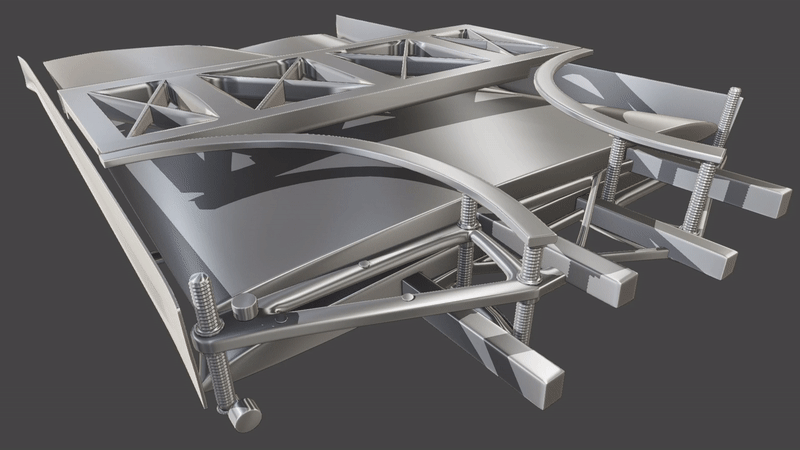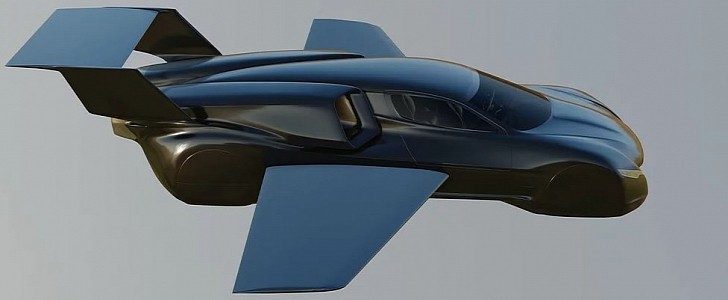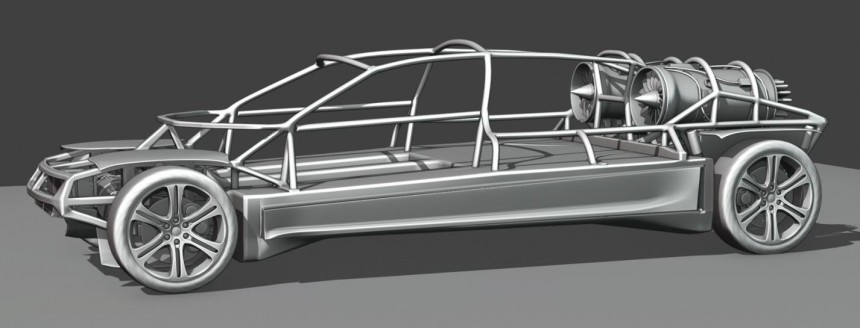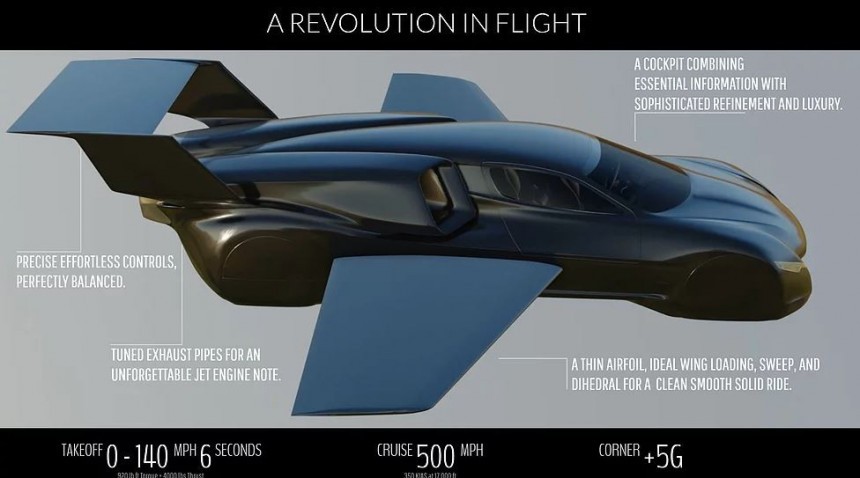Mankind has been looking up at the sky for decades, trying to make an old dream come true: individual flight. Greg Brown’s Firenze Lanciare aims to make it real.
Of course, humanity has mastered the art of flying, so this isn’t about getting up in the air and being able to travel certain distances by flight. Call it the old “Jetsons dream,” but man is still unable to build a vehicle that would make flying more affordable, easier, more convenient and more personal. A flying car is what we need.
However, that flying car won’t be the eVTOLs sucking up millions in investment right now, designer Greg Brown tells the New Atlas. In his opinion, eVTOLs are nothing short of a fad and will only remain a cheaper and more eco-friendly version of the helicopter, but they can’t stand in for an actual flying car because the logistics around them are far too complicated. A car that would work just as well on the road as it did in the air, a flying car in the strictest sense of the word, is what the world needs.
Brown has been developing a concept of a flying car for the past 15 years, drawing on his decades-long experience as pilot of F-18 carrier jets in the US Navy and pilot of 777s for United Airlines. He calls it the Firenze Lanciare, a hypercar by road and a private jet in the air. It’s actually a combination of both: it looks like a much longer and more massive hypercar, and is flight-ready thanks to a pair of hideaway wings.
On the road, Firenze is all-electric, powered by Tesla motors in the front and rear. LG Chem batteries packed neatly in the floor give it a 150-mile (241.4-km) range, while the 1,000 hp and 920 lb-ft of torque would take it from 0 to 60 mph (97 kph) in under 4 seconds.
Inside, there’s room to sit four, though Brown concedes that stripping off the rear seats would make the Firenze less massive (it’s 6.43-meter / 253-inch long) and even faster. But Firenze is already pretty impressive, so why not make it suitable for the entire fam?
Firenze would be a hypercar on the road – and look and feel like one. It would also be the one hypercar in the world to make use of all that power at its disposal, since it would be used on the runway, for takeoff. How many drivers who own hypercars can boast of flooring it for such a long stretch and not break any laws, Brown tells the media outlet.
Before taking off, Firenze deploys the wings, as you can see in the GIF below. They’re stowed away in the chromoly frame, which Brown is looking to build with Armada Engineering, which usually makes Trophy Trucks, Baja buggies and offroad racers. To fly, the hypercar switches from electric to gas which feeds two Williams FJ-33 2000 lb thrust engines sitting at the rear. The wheels come under and into the body of the car while in flight, and there are separate controls for road and air modes, with the latter even allowing the front passenger to serve as co-pilot.

To ensure that every driver can be a pilot without having to worry about flaring to make a soft landing, the Firenze would have big wheels and suspension of the kind you see in offroad racing. “You [don’t] have to land softly, you can just pound 'em on,” Brown explains. “Being an ex-carrier jet pilot myself, I know how easy it is when you don't have to flare to land. Just point at the runway and hit it. And that completely reduces your requirement to be a great pilot.”
The cabin, unlike in current jets, would be hypercar-worthy, with all the luxury trimmings and finishes you expect in a multi-million vehicle. It would also be pressurized, and noise- and sound-insulated.
Brown estimates building the Firenze prototype would cost $20 to $40 million, while one such flying car could go for $5 to $7 million. He has no doubt that he will find buyers for 10 items, assuming he gets to build them, because there are many collectors and private owners who would shill for such a toy for personal use.
Getting FAA certification would be another kettle of fish – and a very expensive one, at $2 billion, and getting road certification would prove equally troublesome.
Because of that last part, Brown is trying to get aviation companies to invest, so they can handle the toughest part on their own, in addition to building the thing. But one thing is certain: if he can build it, people will buy it.
However, that flying car won’t be the eVTOLs sucking up millions in investment right now, designer Greg Brown tells the New Atlas. In his opinion, eVTOLs are nothing short of a fad and will only remain a cheaper and more eco-friendly version of the helicopter, but they can’t stand in for an actual flying car because the logistics around them are far too complicated. A car that would work just as well on the road as it did in the air, a flying car in the strictest sense of the word, is what the world needs.
Brown has been developing a concept of a flying car for the past 15 years, drawing on his decades-long experience as pilot of F-18 carrier jets in the US Navy and pilot of 777s for United Airlines. He calls it the Firenze Lanciare, a hypercar by road and a private jet in the air. It’s actually a combination of both: it looks like a much longer and more massive hypercar, and is flight-ready thanks to a pair of hideaway wings.
Inside, there’s room to sit four, though Brown concedes that stripping off the rear seats would make the Firenze less massive (it’s 6.43-meter / 253-inch long) and even faster. But Firenze is already pretty impressive, so why not make it suitable for the entire fam?
Firenze would be a hypercar on the road – and look and feel like one. It would also be the one hypercar in the world to make use of all that power at its disposal, since it would be used on the runway, for takeoff. How many drivers who own hypercars can boast of flooring it for such a long stretch and not break any laws, Brown tells the media outlet.
Before taking off, Firenze deploys the wings, as you can see in the GIF below. They’re stowed away in the chromoly frame, which Brown is looking to build with Armada Engineering, which usually makes Trophy Trucks, Baja buggies and offroad racers. To fly, the hypercar switches from electric to gas which feeds two Williams FJ-33 2000 lb thrust engines sitting at the rear. The wheels come under and into the body of the car while in flight, and there are separate controls for road and air modes, with the latter even allowing the front passenger to serve as co-pilot.

To ensure that every driver can be a pilot without having to worry about flaring to make a soft landing, the Firenze would have big wheels and suspension of the kind you see in offroad racing. “You [don’t] have to land softly, you can just pound 'em on,” Brown explains. “Being an ex-carrier jet pilot myself, I know how easy it is when you don't have to flare to land. Just point at the runway and hit it. And that completely reduces your requirement to be a great pilot.”
The cabin, unlike in current jets, would be hypercar-worthy, with all the luxury trimmings and finishes you expect in a multi-million vehicle. It would also be pressurized, and noise- and sound-insulated.
Brown estimates building the Firenze prototype would cost $20 to $40 million, while one such flying car could go for $5 to $7 million. He has no doubt that he will find buyers for 10 items, assuming he gets to build them, because there are many collectors and private owners who would shill for such a toy for personal use.
Because of that last part, Brown is trying to get aviation companies to invest, so they can handle the toughest part on their own, in addition to building the thing. But one thing is certain: if he can build it, people will buy it.










